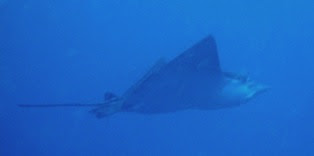


The Galapagos National Park is in charge of the 97% of the islands' land mass. Most of the land and the maritime areas are in a pristine condition, that is, without the influence of human settlement. Park officials, from the time of the Park's founding 50 years ago, have done a spectacular job of maintaining a world for flora and fauna (as well as tourists)that is minimally affected by introduced species. The result is that much marine and land life is not too different from what Charles Darwin observed in 1835. This is especially true on the uninhabited islands, where humans have left few feral dogs, cats, and rats.
The head of the park's educational programs is a wise and affable guy named Marco Hoyos Garcia. He has a crew cut, is from Ambato, talks softly and wisely about the 12years of intractable problems. He has been accused of being unable to wield a big stick, but he is operating successfully in a turbulent political world.
After talking with him, I have a kind of epiphany, realizing that, though I don't get paid for my work, I get to meet stellar folks like Marco Hoyo. He is calm, smart, and patient.
He sees a troubled future in store for the islands and the Park, because the non-park areas are intensely populated by the aggressive species known as "human being" a.k.a. "immigrant" --- this is THE most deadly of all "invasive species." He has some suggestions that make a lot of sense.
"We have to know the facts, first of all. We must find out, scientifically, what to do. We cannot just tell people whatever we think might work; there has to be a basis for what we say. Everyone has a point of view based on their personal preferences, but few can see the scientific truths. Secondly, we have to have enforcement of existing laws, or the laws are not worth the paper they are printed on. The police, Park and national officials cannot just pass the Special Law for the Galapagos and expect it to exist on its own. There has to be law enforcement. Finally, for folks to change their behavior, there must be some incentives. People don't just change. They have to see a reason to change. At this point the only incentive is a negative one.
"At the Park, we try to teach the teachers and the kids by offering them trips on our boats. That way, local people see the Galapagos wildlife and, all of a sudden, they see the reasons to not dump trash, to conserve the environment, and to be proud to be a Galapagueno. This is the incentive we offer.
"My concern is that there is no unity here because people come from many provinces. One day, hopefully, they will know what it means to be a Galapagueno."
Marco also told me that there had been a crisis in community confidence, and that, instead of uniting the community, it has ripped neighbors apart from each other. Here is what happened. A porno ring was discovered, and some residents were arrested and jailed. After the discovery, "experts from the continent" were called to help the community to understand sexual abuse and how to prevent it. In the months that followed, there were revelations of frequent violence against women, including injuries of wives by their husbands in the house and, occasionally, in public. The officials in town encouraged all residents to report any such incidents, so many folks took the recommendation at face value. There were "denuncios" of teachers, mothers and fathers. Now teachers are afraid to touch children, even on their shoulders, and parents fear their neighbors.









